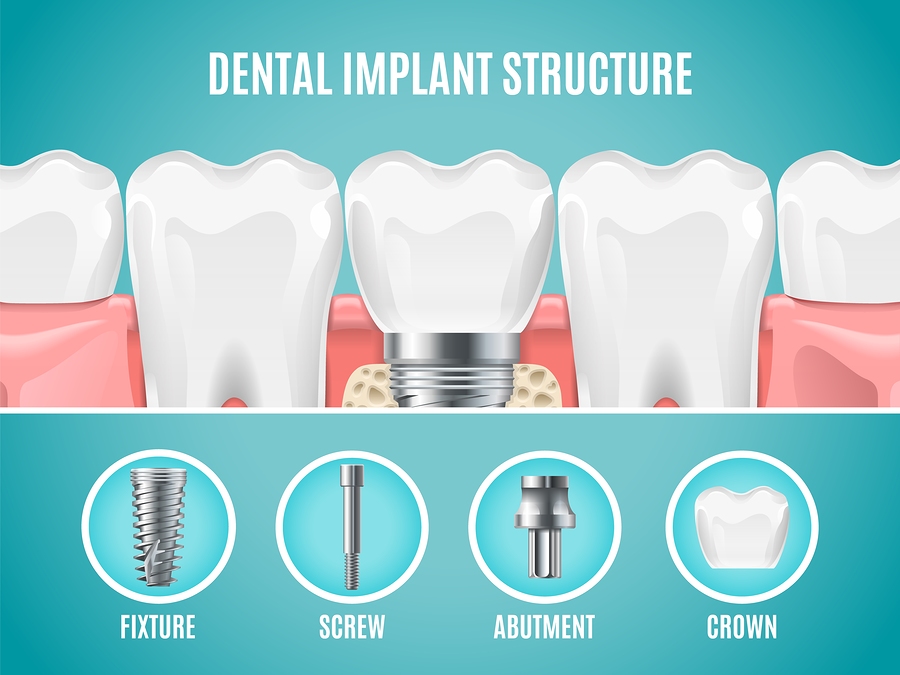All About Dental Sense
Table of ContentsWhat Does Dental Sense Do?The Ultimate Guide To Dental SenseDental Sense Can Be Fun For EveryoneDental Sense Fundamentals Explained
are medical tools surgically implanted right into the jaw to recover an individual's capability to eat or their look. They provide assistance for synthetic (phony) teeth, such as crowns, bridges, or dentures. When a tooth is lost as a result of injury or illness, an individual can experience difficulties such as rapid bone loss, malfunctioning speech, or adjustments to eating patterns that result in pain.Dental implant systems are composed of an oral implant body and oral implant joint and might additionally consist of an abutment addiction screw. Root canal procedure. The oral implant body is operatively placed in the jawbone instead of the tooth's origin. The oral implant joint is generally affixed to the dental implant body by the abutment addiction screw and extends via gum tissues right into the mouth to support the affixed artificial teeth
(https://myanimelist.net/profile/dentalsense1)Structure of The Oral Implant System selecting dental implants, speak with your oral service provider regarding the prospective benefits and threats, and whether you are a prospect for the treatment. Points to take into consideration: Your overall wellness is an essential consider establishing whether you are a good candidate for oral implants, the length of time it will take to recover, and the length of time the implant may stay in location.
Cigarette smoking may influence the recovery process and lower the long-term success of the implant. The healing process for the implant body might take a number of months or longer, during which time you usually have a temporary abutment instead of the tooth. the dental implant treatment: Very carefully follow the oral hygiene guidelines provided to you by your dental company.
Some Ideas on Dental Sense You Need To Know
Implant failing can result in the requirement for one more surgery to take care of or replace the dental implant system. Recovers the ability to eat Brings back aesthetic look Assists keep the jawbone from diminishing due to bone loss Preserves the health and wellness of the bordering bone and gums Aids maintain adjacent (nearby) teeth steady Improves lifestyle Damages to surrounding all-natural teeth during implant positioning Injury to the surrounding cells throughout surgical treatment, such as sinus opening Injury throughout surgical procedure (for example, fracture of bordering jawbone) Poor feature, such as seeming like the teeth do not bite with each other generally A feeling that the tooth is loosened or turning in place resulting from a joint screw loosening up Implant body failing (looseness of the implant body) because of systemic infection, which might be more probable in patients with uncontrolled diabetes mellitus due to neighborhood infection in bone and gums supporting the implant body as a result of delayed recovery, which may be most likely in people that smoke Trouble cleaning the periodontals around the implant, leading to bad dental health Unattended periodontal disease Post-surgical feeling numb as a result of nerve impingement or damages Constantly notify healthcare providers and imaging service technicians that you have dental implants prior to any magnetic resonance imaging (MRI) or x-ray procedures.
FDA is not knowledgeable about any kind of damaging occasions reported for MRI or x-ray treatments with oral implants. Oral implants systems are typically constructed from products that comply with global consensus requirements of the International Organization for Standardization (ISO) or ASTM International. These requirements have information of what makes a secure product.

An oral implant is a structure that replaces a missing tooth. With screw-like devices, the doctor inserts a dental implant right into the jawbone, and it acts as a support for an artificial tooth, called a crown.
4 Easy Facts About Dental Sense Shown
Some people are not eligible for dental implant surgical treatment. It is for dental doctors to run on people with: intense illnessuncontrollable metabolic diseasebone or soft cells condition or infectionIf these concerns are solved, an individual can have the surgical treatment. In, oral specialists avoid from running on individuals with: If individuals with any of the above go through oral implant surgery, there is a greater risk of the get redirected here implant failing.

Oral dental implant surgical procedure is a tailored process. It's not the same for everybody. The adhering to offers a general summary of what you can anticipate your dental practitioner, oral doctor, periodontist or prosthodontist to do: Put the dental implant surgically. Provide you time to heal. Connect the message and last crown, bridge or denture.
Next off, your specialist will very carefully position the dental implant right into your jaw. Lastly, your specialist will reposition your gum tissues and close the laceration with stitches. If your dental implant is near the front of your mouth, your dentist will certainly make a short-lived tooth for you to use up until you recover. By doing this, you won't have a gap in your smile while you recover.
How Dental Sense can Save You Time, Stress, and Money.
Your company can inform you what to expect in your situation. Throughout the recovery phase, your jawbone needs to fuse to the oral implant. This procedure, called osseointegration, is important for stability and lasting success. This procedure can take anywhere from 3 to 9 months. In many cases, it may take longer.
When your implant heals, your dental professional can connect the abutment (little port blog post) and your final restoration (crown, bridge or denture). This usually takes concerning one hour to complete and may call for a 2nd minor surgical treatment. You shouldn't really feel any pain during your oral implant procedure since your supplier will use medicine to numb your gum tissues.